Analyzing Japan's Economic Performance: A 10-Year Macroeconomic Review
VerifiedAdded on 2022/10/11
|12
|2818
|21
Essay
AI Summary
This essay provides a comprehensive analysis of Japan's economic performance from 2008 to 2018, focusing on key macroeconomic indicators. It examines the trends in real GDP, unemployment rate, and inflation, highlighting the impact of the 2008 financial crisis and subsequent economic events. The analysis delves into the government's policies aimed at achieving full employment, stable prices, and economic growth, including fiscal stimulus packages and structural reforms. The essay explores the types of unemployment experienced in Japan and the government's measures to address it, along with the causes of inflation and deflation during the period. The study uses graphical representations to illustrate the trends and provides a detailed discussion of the overall performance of the Japanese economy, supported by researched evidence and economic theories. The essay concludes with an assessment of the economic performance, considering the strengths and weaknesses observed throughout the decade.
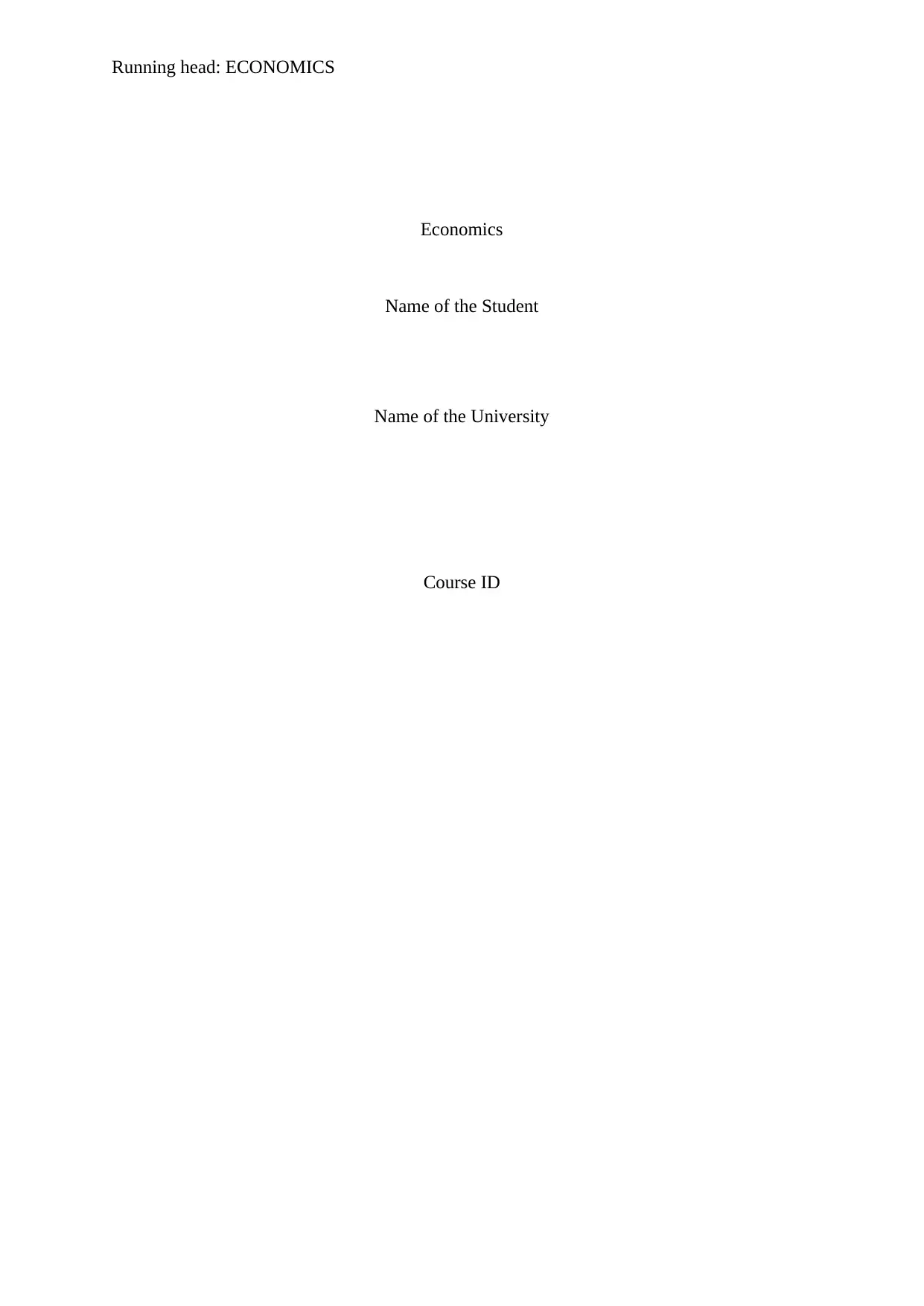
Running head: ECONOMICS
Economics
Name of the Student
Name of the University
Course ID
Economics
Name of the Student
Name of the University
Course ID
Paraphrase This Document
Need a fresh take? Get an instant paraphrase of this document with our AI Paraphraser
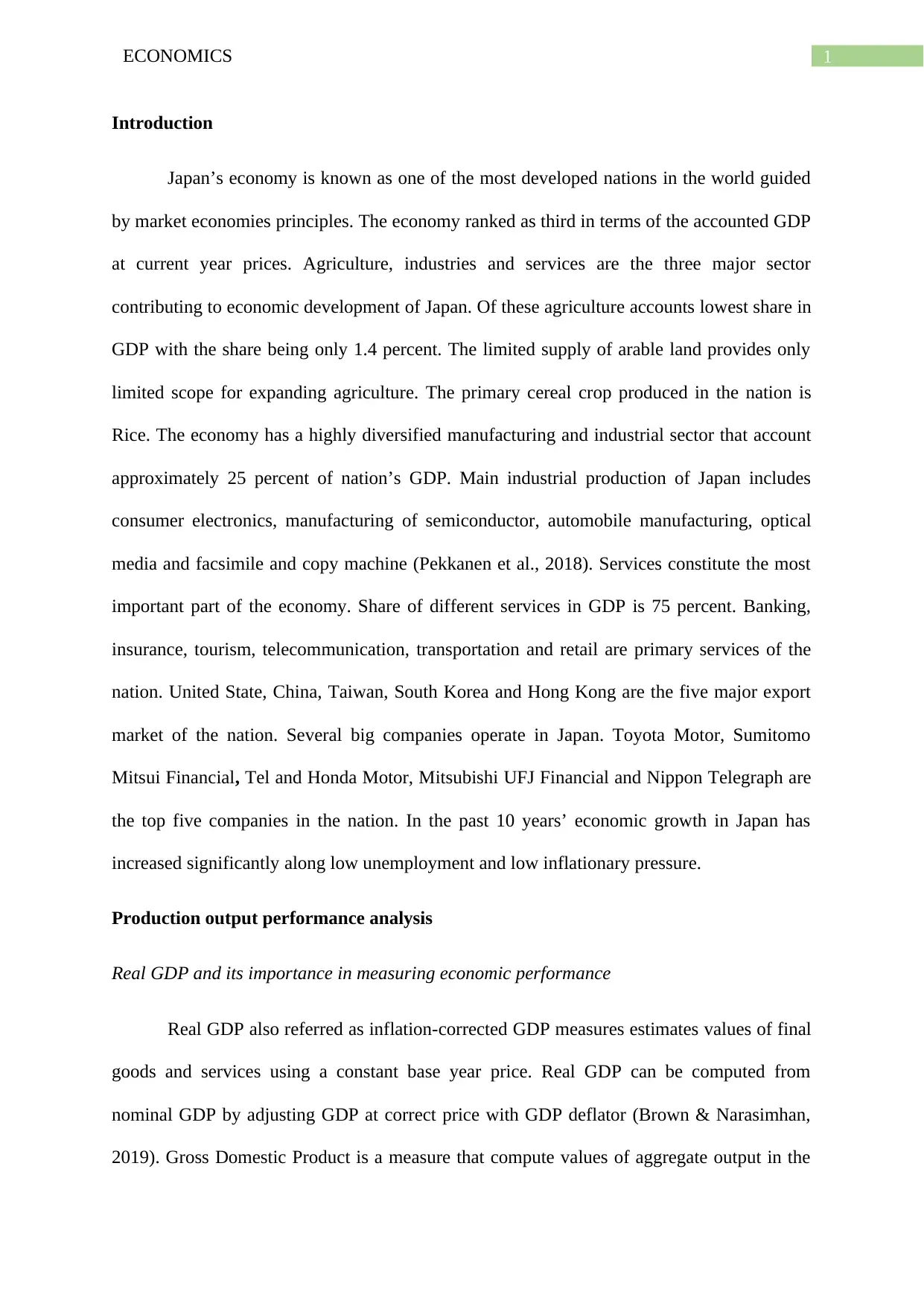
1ECONOMICS
Introduction
Japan’s economy is known as one of the most developed nations in the world guided
by market economies principles. The economy ranked as third in terms of the accounted GDP
at current year prices. Agriculture, industries and services are the three major sector
contributing to economic development of Japan. Of these agriculture accounts lowest share in
GDP with the share being only 1.4 percent. The limited supply of arable land provides only
limited scope for expanding agriculture. The primary cereal crop produced in the nation is
Rice. The economy has a highly diversified manufacturing and industrial sector that account
approximately 25 percent of nation’s GDP. Main industrial production of Japan includes
consumer electronics, manufacturing of semiconductor, automobile manufacturing, optical
media and facsimile and copy machine (Pekkanen et al., 2018). Services constitute the most
important part of the economy. Share of different services in GDP is 75 percent. Banking,
insurance, tourism, telecommunication, transportation and retail are primary services of the
nation. United State, China, Taiwan, South Korea and Hong Kong are the five major export
market of the nation. Several big companies operate in Japan. Toyota Motor, Sumitomo
Mitsui Financial, Tel and Honda Motor, Mitsubishi UFJ Financial and Nippon Telegraph are
the top five companies in the nation. In the past 10 years’ economic growth in Japan has
increased significantly along low unemployment and low inflationary pressure.
Production output performance analysis
Real GDP and its importance in measuring economic performance
Real GDP also referred as inflation-corrected GDP measures estimates values of final
goods and services using a constant base year price. Real GDP can be computed from
nominal GDP by adjusting GDP at correct price with GDP deflator (Brown & Narasimhan,
2019). Gross Domestic Product is a measure that compute values of aggregate output in the
Introduction
Japan’s economy is known as one of the most developed nations in the world guided
by market economies principles. The economy ranked as third in terms of the accounted GDP
at current year prices. Agriculture, industries and services are the three major sector
contributing to economic development of Japan. Of these agriculture accounts lowest share in
GDP with the share being only 1.4 percent. The limited supply of arable land provides only
limited scope for expanding agriculture. The primary cereal crop produced in the nation is
Rice. The economy has a highly diversified manufacturing and industrial sector that account
approximately 25 percent of nation’s GDP. Main industrial production of Japan includes
consumer electronics, manufacturing of semiconductor, automobile manufacturing, optical
media and facsimile and copy machine (Pekkanen et al., 2018). Services constitute the most
important part of the economy. Share of different services in GDP is 75 percent. Banking,
insurance, tourism, telecommunication, transportation and retail are primary services of the
nation. United State, China, Taiwan, South Korea and Hong Kong are the five major export
market of the nation. Several big companies operate in Japan. Toyota Motor, Sumitomo
Mitsui Financial, Tel and Honda Motor, Mitsubishi UFJ Financial and Nippon Telegraph are
the top five companies in the nation. In the past 10 years’ economic growth in Japan has
increased significantly along low unemployment and low inflationary pressure.
Production output performance analysis
Real GDP and its importance in measuring economic performance
Real GDP also referred as inflation-corrected GDP measures estimates values of final
goods and services using a constant base year price. Real GDP can be computed from
nominal GDP by adjusting GDP at correct price with GDP deflator (Brown & Narasimhan,
2019). Gross Domestic Product is a measure that compute values of aggregate output in the
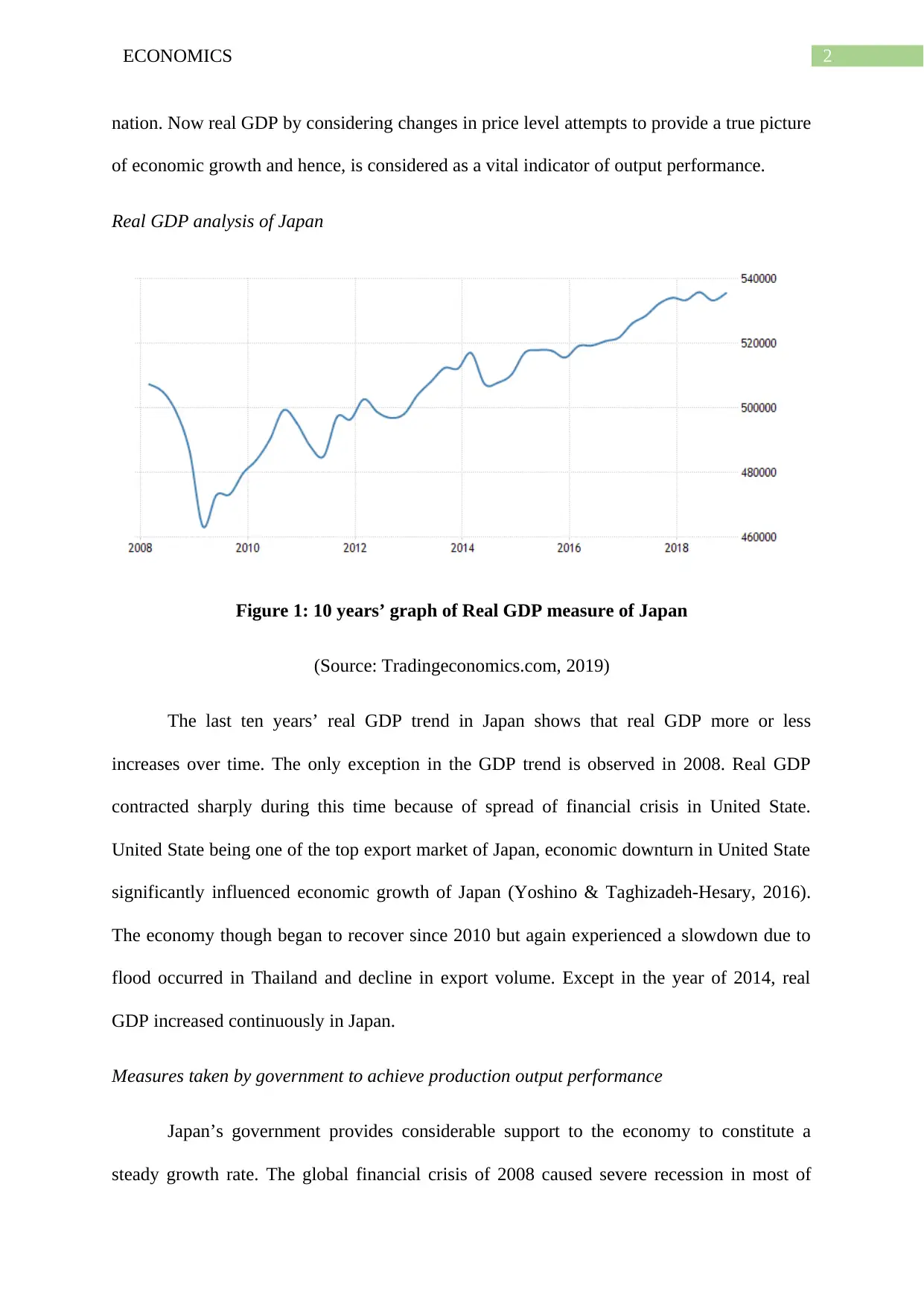
2ECONOMICS
nation. Now real GDP by considering changes in price level attempts to provide a true picture
of economic growth and hence, is considered as a vital indicator of output performance.
Real GDP analysis of Japan
Figure 1: 10 years’ graph of Real GDP measure of Japan
(Source: Tradingeconomics.com, 2019)
The last ten years’ real GDP trend in Japan shows that real GDP more or less
increases over time. The only exception in the GDP trend is observed in 2008. Real GDP
contracted sharply during this time because of spread of financial crisis in United State.
United State being one of the top export market of Japan, economic downturn in United State
significantly influenced economic growth of Japan (Yoshino & Taghizadeh‐Hesary, 2016).
The economy though began to recover since 2010 but again experienced a slowdown due to
flood occurred in Thailand and decline in export volume. Except in the year of 2014, real
GDP increased continuously in Japan.
Measures taken by government to achieve production output performance
Japan’s government provides considerable support to the economy to constitute a
steady growth rate. The global financial crisis of 2008 caused severe recession in most of
nation. Now real GDP by considering changes in price level attempts to provide a true picture
of economic growth and hence, is considered as a vital indicator of output performance.
Real GDP analysis of Japan
Figure 1: 10 years’ graph of Real GDP measure of Japan
(Source: Tradingeconomics.com, 2019)
The last ten years’ real GDP trend in Japan shows that real GDP more or less
increases over time. The only exception in the GDP trend is observed in 2008. Real GDP
contracted sharply during this time because of spread of financial crisis in United State.
United State being one of the top export market of Japan, economic downturn in United State
significantly influenced economic growth of Japan (Yoshino & Taghizadeh‐Hesary, 2016).
The economy though began to recover since 2010 but again experienced a slowdown due to
flood occurred in Thailand and decline in export volume. Except in the year of 2014, real
GDP increased continuously in Japan.
Measures taken by government to achieve production output performance
Japan’s government provides considerable support to the economy to constitute a
steady growth rate. The global financial crisis of 2008 caused severe recession in most of
⊘ This is a preview!⊘
Do you want full access?
Subscribe today to unlock all pages.

Trusted by 1+ million students worldwide
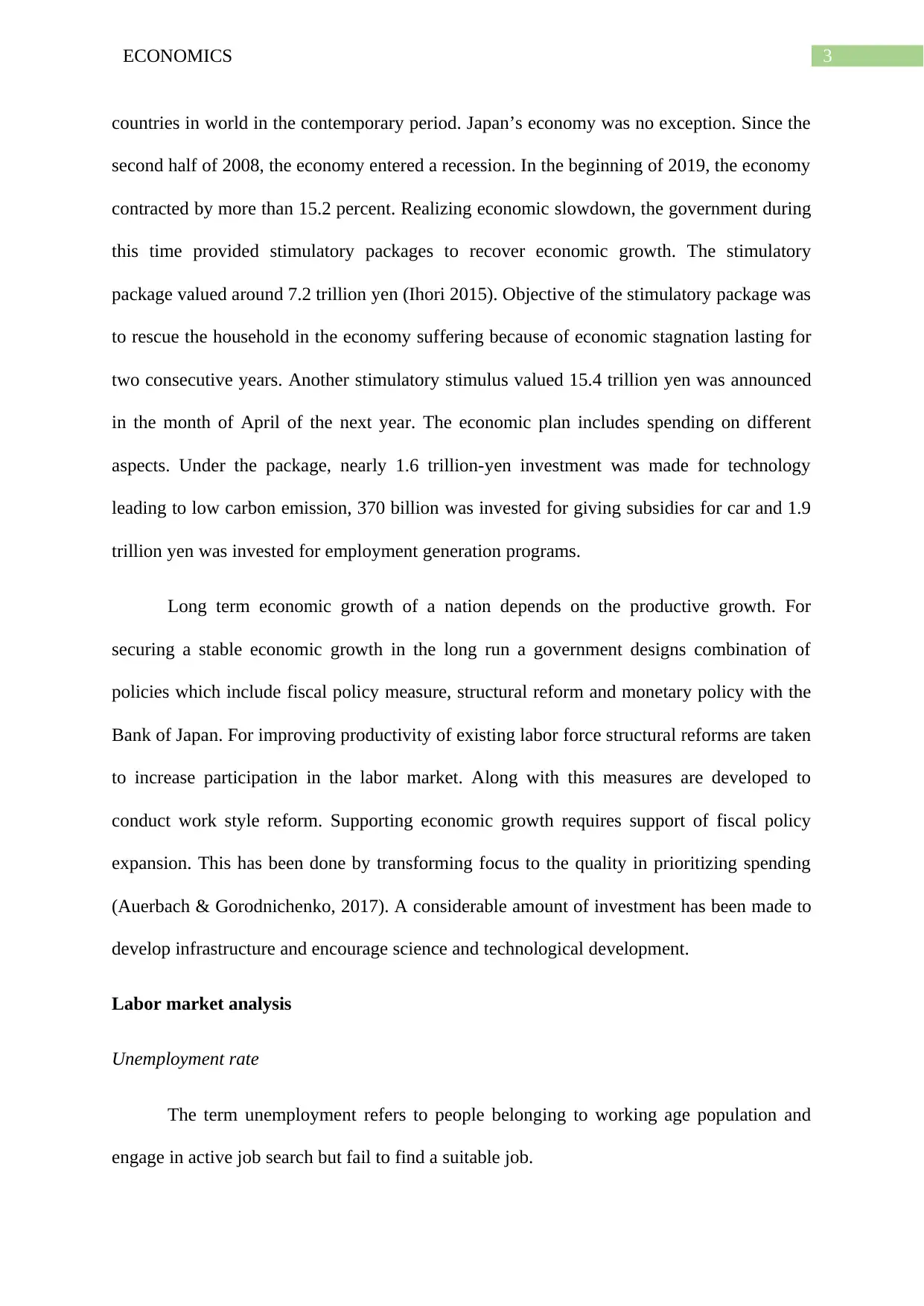
3ECONOMICS
countries in world in the contemporary period. Japan’s economy was no exception. Since the
second half of 2008, the economy entered a recession. In the beginning of 2019, the economy
contracted by more than 15.2 percent. Realizing economic slowdown, the government during
this time provided stimulatory packages to recover economic growth. The stimulatory
package valued around 7.2 trillion yen (Ihori 2015). Objective of the stimulatory package was
to rescue the household in the economy suffering because of economic stagnation lasting for
two consecutive years. Another stimulatory stimulus valued 15.4 trillion yen was announced
in the month of April of the next year. The economic plan includes spending on different
aspects. Under the package, nearly 1.6 trillion-yen investment was made for technology
leading to low carbon emission, 370 billion was invested for giving subsidies for car and 1.9
trillion yen was invested for employment generation programs.
Long term economic growth of a nation depends on the productive growth. For
securing a stable economic growth in the long run a government designs combination of
policies which include fiscal policy measure, structural reform and monetary policy with the
Bank of Japan. For improving productivity of existing labor force structural reforms are taken
to increase participation in the labor market. Along with this measures are developed to
conduct work style reform. Supporting economic growth requires support of fiscal policy
expansion. This has been done by transforming focus to the quality in prioritizing spending
(Auerbach & Gorodnichenko, 2017). A considerable amount of investment has been made to
develop infrastructure and encourage science and technological development.
Labor market analysis
Unemployment rate
The term unemployment refers to people belonging to working age population and
engage in active job search but fail to find a suitable job.
countries in world in the contemporary period. Japan’s economy was no exception. Since the
second half of 2008, the economy entered a recession. In the beginning of 2019, the economy
contracted by more than 15.2 percent. Realizing economic slowdown, the government during
this time provided stimulatory packages to recover economic growth. The stimulatory
package valued around 7.2 trillion yen (Ihori 2015). Objective of the stimulatory package was
to rescue the household in the economy suffering because of economic stagnation lasting for
two consecutive years. Another stimulatory stimulus valued 15.4 trillion yen was announced
in the month of April of the next year. The economic plan includes spending on different
aspects. Under the package, nearly 1.6 trillion-yen investment was made for technology
leading to low carbon emission, 370 billion was invested for giving subsidies for car and 1.9
trillion yen was invested for employment generation programs.
Long term economic growth of a nation depends on the productive growth. For
securing a stable economic growth in the long run a government designs combination of
policies which include fiscal policy measure, structural reform and monetary policy with the
Bank of Japan. For improving productivity of existing labor force structural reforms are taken
to increase participation in the labor market. Along with this measures are developed to
conduct work style reform. Supporting economic growth requires support of fiscal policy
expansion. This has been done by transforming focus to the quality in prioritizing spending
(Auerbach & Gorodnichenko, 2017). A considerable amount of investment has been made to
develop infrastructure and encourage science and technological development.
Labor market analysis
Unemployment rate
The term unemployment refers to people belonging to working age population and
engage in active job search but fail to find a suitable job.
Paraphrase This Document
Need a fresh take? Get an instant paraphrase of this document with our AI Paraphraser
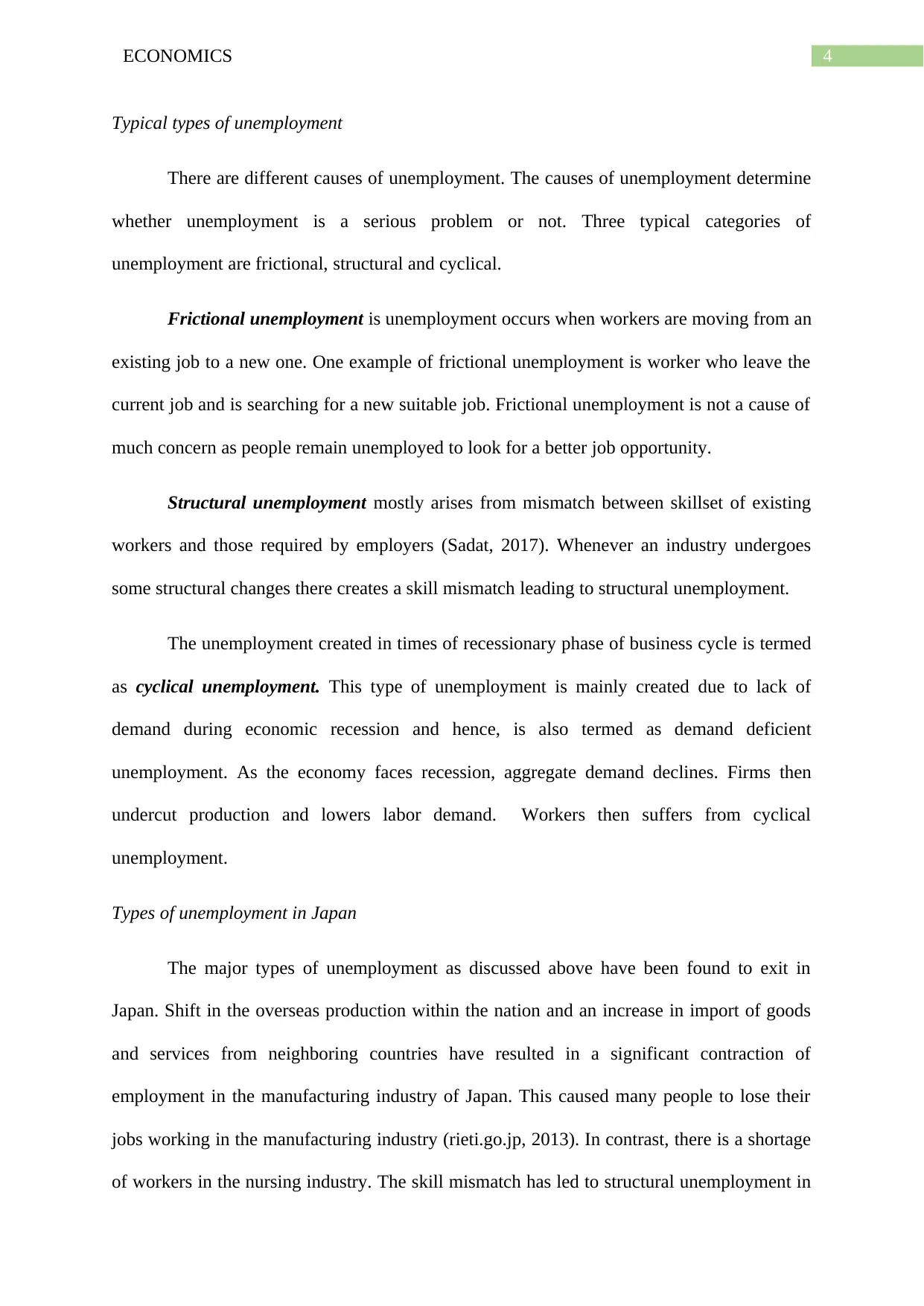
4ECONOMICS
Typical types of unemployment
There are different causes of unemployment. The causes of unemployment determine
whether unemployment is a serious problem or not. Three typical categories of
unemployment are frictional, structural and cyclical.
Frictional unemployment is unemployment occurs when workers are moving from an
existing job to a new one. One example of frictional unemployment is worker who leave the
current job and is searching for a new suitable job. Frictional unemployment is not a cause of
much concern as people remain unemployed to look for a better job opportunity.
Structural unemployment mostly arises from mismatch between skillset of existing
workers and those required by employers (Sadat, 2017). Whenever an industry undergoes
some structural changes there creates a skill mismatch leading to structural unemployment.
The unemployment created in times of recessionary phase of business cycle is termed
as cyclical unemployment. This type of unemployment is mainly created due to lack of
demand during economic recession and hence, is also termed as demand deficient
unemployment. As the economy faces recession, aggregate demand declines. Firms then
undercut production and lowers labor demand. Workers then suffers from cyclical
unemployment.
Types of unemployment in Japan
The major types of unemployment as discussed above have been found to exit in
Japan. Shift in the overseas production within the nation and an increase in import of goods
and services from neighboring countries have resulted in a significant contraction of
employment in the manufacturing industry of Japan. This caused many people to lose their
jobs working in the manufacturing industry (rieti.go.jp, 2013). In contrast, there is a shortage
of workers in the nursing industry. The skill mismatch has led to structural unemployment in
Typical types of unemployment
There are different causes of unemployment. The causes of unemployment determine
whether unemployment is a serious problem or not. Three typical categories of
unemployment are frictional, structural and cyclical.
Frictional unemployment is unemployment occurs when workers are moving from an
existing job to a new one. One example of frictional unemployment is worker who leave the
current job and is searching for a new suitable job. Frictional unemployment is not a cause of
much concern as people remain unemployed to look for a better job opportunity.
Structural unemployment mostly arises from mismatch between skillset of existing
workers and those required by employers (Sadat, 2017). Whenever an industry undergoes
some structural changes there creates a skill mismatch leading to structural unemployment.
The unemployment created in times of recessionary phase of business cycle is termed
as cyclical unemployment. This type of unemployment is mainly created due to lack of
demand during economic recession and hence, is also termed as demand deficient
unemployment. As the economy faces recession, aggregate demand declines. Firms then
undercut production and lowers labor demand. Workers then suffers from cyclical
unemployment.
Types of unemployment in Japan
The major types of unemployment as discussed above have been found to exit in
Japan. Shift in the overseas production within the nation and an increase in import of goods
and services from neighboring countries have resulted in a significant contraction of
employment in the manufacturing industry of Japan. This caused many people to lose their
jobs working in the manufacturing industry (rieti.go.jp, 2013). In contrast, there is a shortage
of workers in the nursing industry. The skill mismatch has led to structural unemployment in
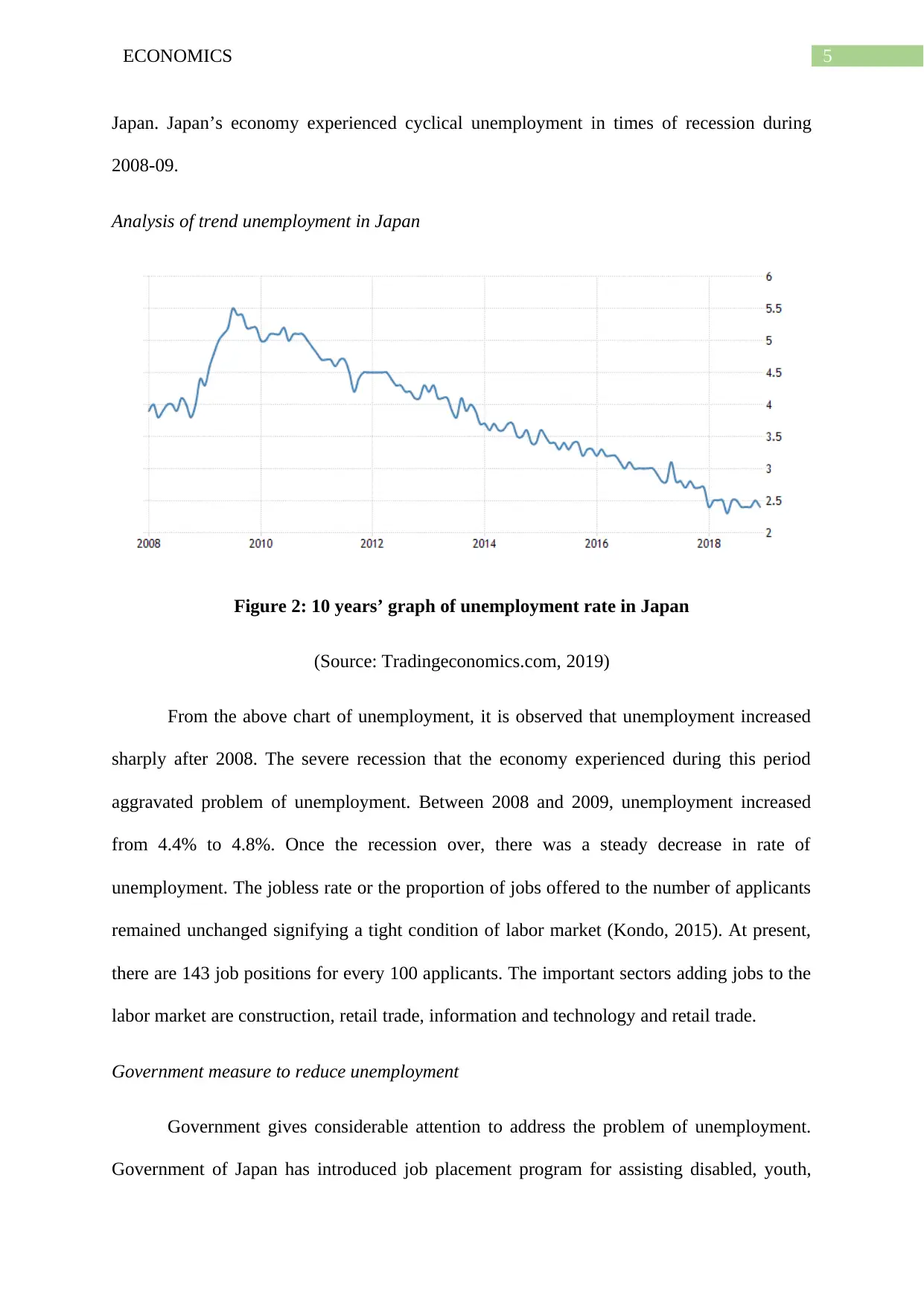
5ECONOMICS
Japan. Japan’s economy experienced cyclical unemployment in times of recession during
2008-09.
Analysis of trend unemployment in Japan
Figure 2: 10 years’ graph of unemployment rate in Japan
(Source: Tradingeconomics.com, 2019)
From the above chart of unemployment, it is observed that unemployment increased
sharply after 2008. The severe recession that the economy experienced during this period
aggravated problem of unemployment. Between 2008 and 2009, unemployment increased
from 4.4% to 4.8%. Once the recession over, there was a steady decrease in rate of
unemployment. The jobless rate or the proportion of jobs offered to the number of applicants
remained unchanged signifying a tight condition of labor market (Kondo, 2015). At present,
there are 143 job positions for every 100 applicants. The important sectors adding jobs to the
labor market are construction, retail trade, information and technology and retail trade.
Government measure to reduce unemployment
Government gives considerable attention to address the problem of unemployment.
Government of Japan has introduced job placement program for assisting disabled, youth,
Japan. Japan’s economy experienced cyclical unemployment in times of recession during
2008-09.
Analysis of trend unemployment in Japan
Figure 2: 10 years’ graph of unemployment rate in Japan
(Source: Tradingeconomics.com, 2019)
From the above chart of unemployment, it is observed that unemployment increased
sharply after 2008. The severe recession that the economy experienced during this period
aggravated problem of unemployment. Between 2008 and 2009, unemployment increased
from 4.4% to 4.8%. Once the recession over, there was a steady decrease in rate of
unemployment. The jobless rate or the proportion of jobs offered to the number of applicants
remained unchanged signifying a tight condition of labor market (Kondo, 2015). At present,
there are 143 job positions for every 100 applicants. The important sectors adding jobs to the
labor market are construction, retail trade, information and technology and retail trade.
Government measure to reduce unemployment
Government gives considerable attention to address the problem of unemployment.
Government of Japan has introduced job placement program for assisting disabled, youth,
⊘ This is a preview!⊘
Do you want full access?
Subscribe today to unlock all pages.

Trusted by 1+ million students worldwide
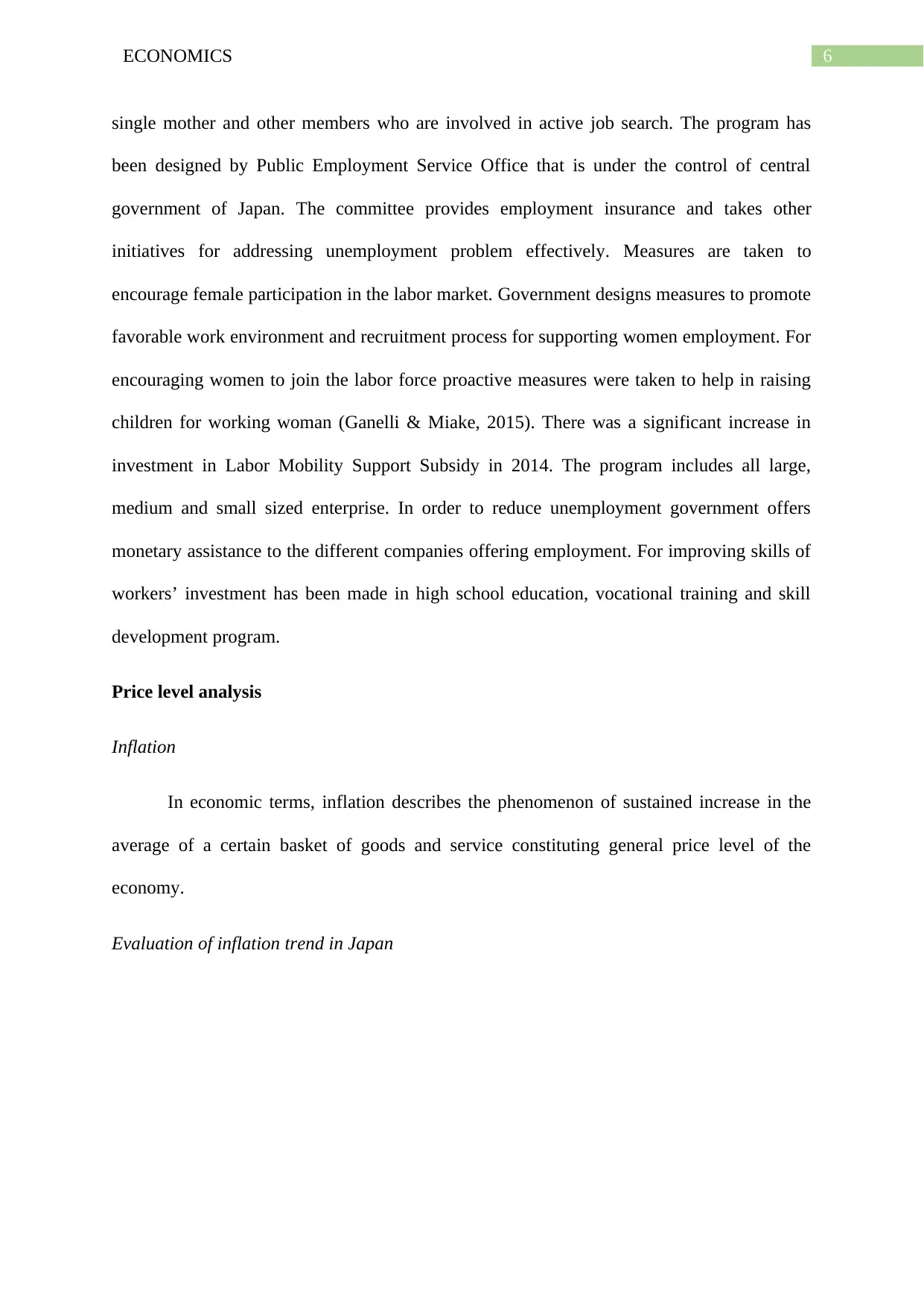
6ECONOMICS
single mother and other members who are involved in active job search. The program has
been designed by Public Employment Service Office that is under the control of central
government of Japan. The committee provides employment insurance and takes other
initiatives for addressing unemployment problem effectively. Measures are taken to
encourage female participation in the labor market. Government designs measures to promote
favorable work environment and recruitment process for supporting women employment. For
encouraging women to join the labor force proactive measures were taken to help in raising
children for working woman (Ganelli & Miake, 2015). There was a significant increase in
investment in Labor Mobility Support Subsidy in 2014. The program includes all large,
medium and small sized enterprise. In order to reduce unemployment government offers
monetary assistance to the different companies offering employment. For improving skills of
workers’ investment has been made in high school education, vocational training and skill
development program.
Price level analysis
Inflation
In economic terms, inflation describes the phenomenon of sustained increase in the
average of a certain basket of goods and service constituting general price level of the
economy.
Evaluation of inflation trend in Japan
single mother and other members who are involved in active job search. The program has
been designed by Public Employment Service Office that is under the control of central
government of Japan. The committee provides employment insurance and takes other
initiatives for addressing unemployment problem effectively. Measures are taken to
encourage female participation in the labor market. Government designs measures to promote
favorable work environment and recruitment process for supporting women employment. For
encouraging women to join the labor force proactive measures were taken to help in raising
children for working woman (Ganelli & Miake, 2015). There was a significant increase in
investment in Labor Mobility Support Subsidy in 2014. The program includes all large,
medium and small sized enterprise. In order to reduce unemployment government offers
monetary assistance to the different companies offering employment. For improving skills of
workers’ investment has been made in high school education, vocational training and skill
development program.
Price level analysis
Inflation
In economic terms, inflation describes the phenomenon of sustained increase in the
average of a certain basket of goods and service constituting general price level of the
economy.
Evaluation of inflation trend in Japan
Paraphrase This Document
Need a fresh take? Get an instant paraphrase of this document with our AI Paraphraser
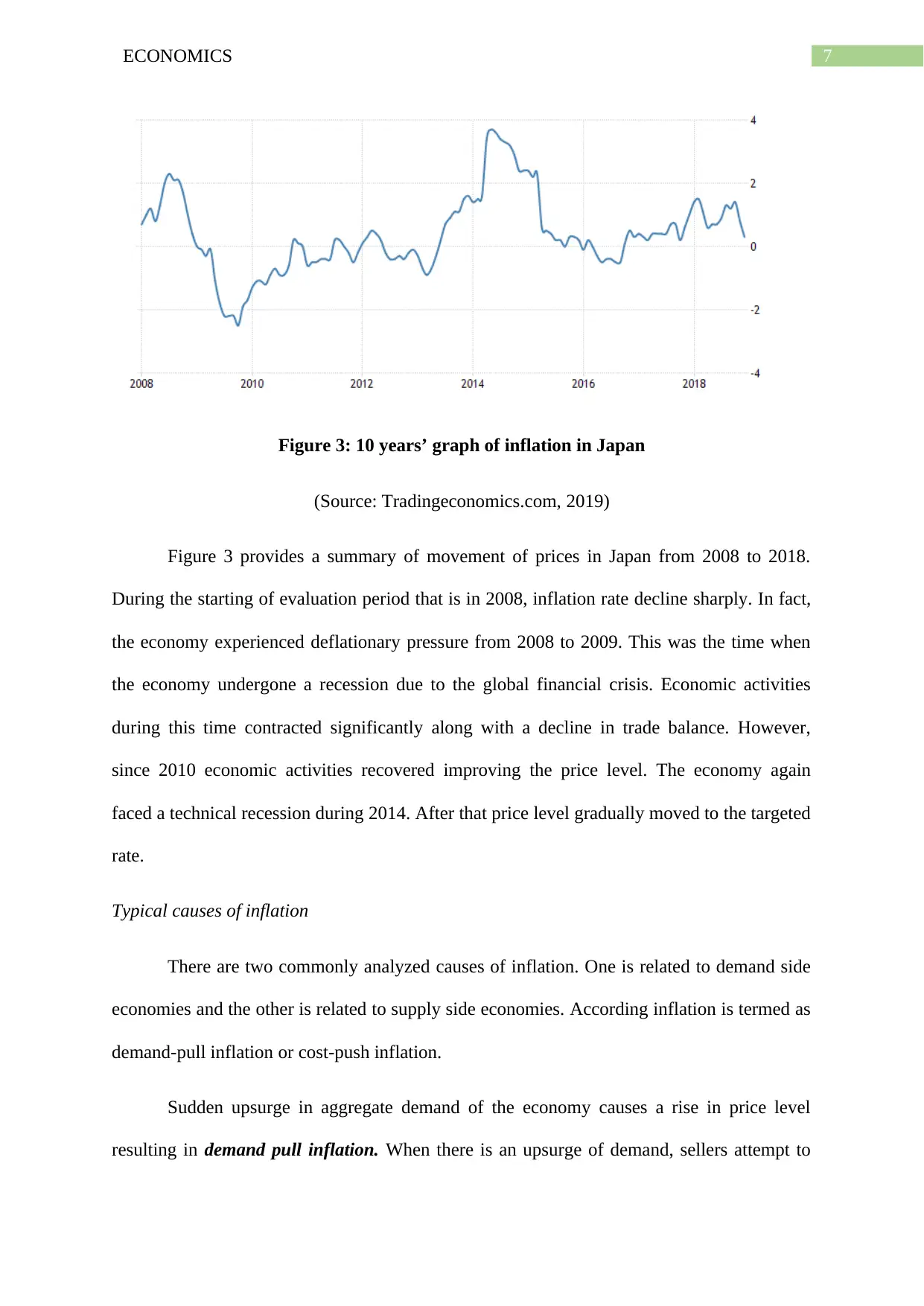
7ECONOMICS
Figure 3: 10 years’ graph of inflation in Japan
(Source: Tradingeconomics.com, 2019)
Figure 3 provides a summary of movement of prices in Japan from 2008 to 2018.
During the starting of evaluation period that is in 2008, inflation rate decline sharply. In fact,
the economy experienced deflationary pressure from 2008 to 2009. This was the time when
the economy undergone a recession due to the global financial crisis. Economic activities
during this time contracted significantly along with a decline in trade balance. However,
since 2010 economic activities recovered improving the price level. The economy again
faced a technical recession during 2014. After that price level gradually moved to the targeted
rate.
Typical causes of inflation
There are two commonly analyzed causes of inflation. One is related to demand side
economies and the other is related to supply side economies. According inflation is termed as
demand-pull inflation or cost-push inflation.
Sudden upsurge in aggregate demand of the economy causes a rise in price level
resulting in demand pull inflation. When there is an upsurge of demand, sellers attempt to
Figure 3: 10 years’ graph of inflation in Japan
(Source: Tradingeconomics.com, 2019)
Figure 3 provides a summary of movement of prices in Japan from 2008 to 2018.
During the starting of evaluation period that is in 2008, inflation rate decline sharply. In fact,
the economy experienced deflationary pressure from 2008 to 2009. This was the time when
the economy undergone a recession due to the global financial crisis. Economic activities
during this time contracted significantly along with a decline in trade balance. However,
since 2010 economic activities recovered improving the price level. The economy again
faced a technical recession during 2014. After that price level gradually moved to the targeted
rate.
Typical causes of inflation
There are two commonly analyzed causes of inflation. One is related to demand side
economies and the other is related to supply side economies. According inflation is termed as
demand-pull inflation or cost-push inflation.
Sudden upsurge in aggregate demand of the economy causes a rise in price level
resulting in demand pull inflation. When there is an upsurge of demand, sellers attempt to
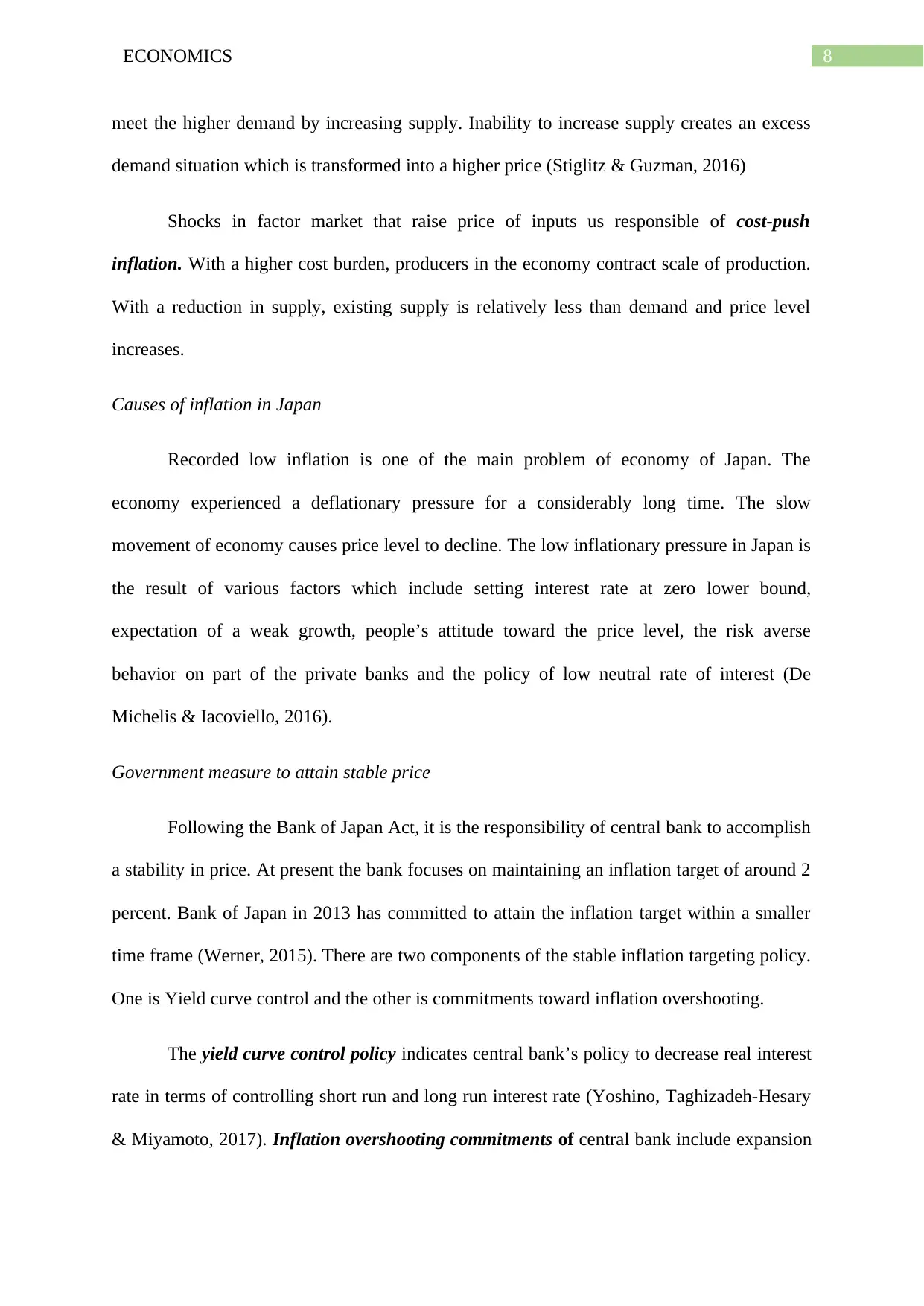
8ECONOMICS
meet the higher demand by increasing supply. Inability to increase supply creates an excess
demand situation which is transformed into a higher price (Stiglitz & Guzman, 2016)
Shocks in factor market that raise price of inputs us responsible of cost-push
inflation. With a higher cost burden, producers in the economy contract scale of production.
With a reduction in supply, existing supply is relatively less than demand and price level
increases.
Causes of inflation in Japan
Recorded low inflation is one of the main problem of economy of Japan. The
economy experienced a deflationary pressure for a considerably long time. The slow
movement of economy causes price level to decline. The low inflationary pressure in Japan is
the result of various factors which include setting interest rate at zero lower bound,
expectation of a weak growth, people’s attitude toward the price level, the risk averse
behavior on part of the private banks and the policy of low neutral rate of interest (De
Michelis & Iacoviello, 2016).
Government measure to attain stable price
Following the Bank of Japan Act, it is the responsibility of central bank to accomplish
a stability in price. At present the bank focuses on maintaining an inflation target of around 2
percent. Bank of Japan in 2013 has committed to attain the inflation target within a smaller
time frame (Werner, 2015). There are two components of the stable inflation targeting policy.
One is Yield curve control and the other is commitments toward inflation overshooting.
The yield curve control policy indicates central bank’s policy to decrease real interest
rate in terms of controlling short run and long run interest rate (Yoshino, Taghizadeh-Hesary
& Miyamoto, 2017). Inflation overshooting commitments of central bank include expansion
meet the higher demand by increasing supply. Inability to increase supply creates an excess
demand situation which is transformed into a higher price (Stiglitz & Guzman, 2016)
Shocks in factor market that raise price of inputs us responsible of cost-push
inflation. With a higher cost burden, producers in the economy contract scale of production.
With a reduction in supply, existing supply is relatively less than demand and price level
increases.
Causes of inflation in Japan
Recorded low inflation is one of the main problem of economy of Japan. The
economy experienced a deflationary pressure for a considerably long time. The slow
movement of economy causes price level to decline. The low inflationary pressure in Japan is
the result of various factors which include setting interest rate at zero lower bound,
expectation of a weak growth, people’s attitude toward the price level, the risk averse
behavior on part of the private banks and the policy of low neutral rate of interest (De
Michelis & Iacoviello, 2016).
Government measure to attain stable price
Following the Bank of Japan Act, it is the responsibility of central bank to accomplish
a stability in price. At present the bank focuses on maintaining an inflation target of around 2
percent. Bank of Japan in 2013 has committed to attain the inflation target within a smaller
time frame (Werner, 2015). There are two components of the stable inflation targeting policy.
One is Yield curve control and the other is commitments toward inflation overshooting.
The yield curve control policy indicates central bank’s policy to decrease real interest
rate in terms of controlling short run and long run interest rate (Yoshino, Taghizadeh-Hesary
& Miyamoto, 2017). Inflation overshooting commitments of central bank include expansion
⊘ This is a preview!⊘
Do you want full access?
Subscribe today to unlock all pages.

Trusted by 1+ million students worldwide
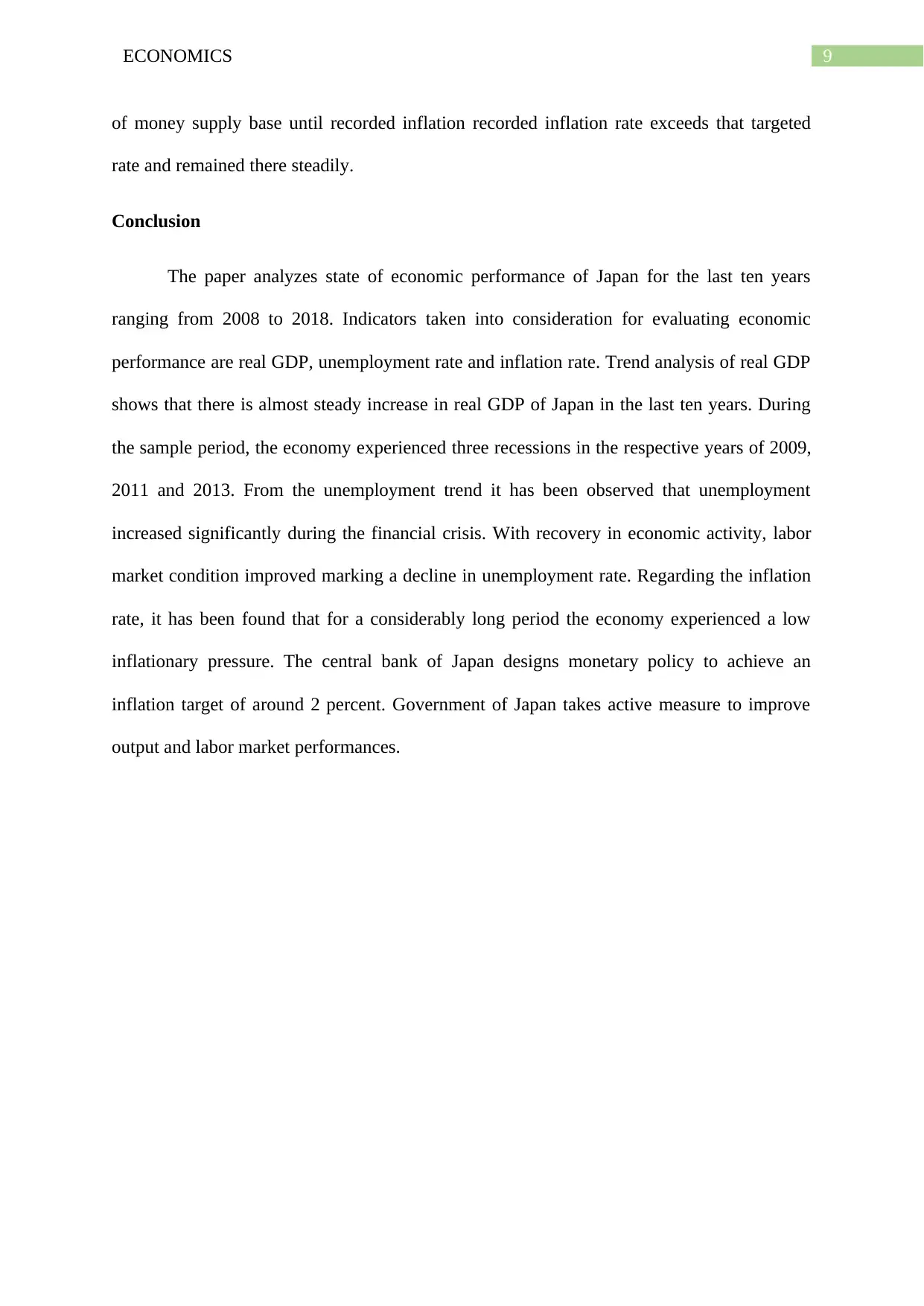
9ECONOMICS
of money supply base until recorded inflation recorded inflation rate exceeds that targeted
rate and remained there steadily.
Conclusion
The paper analyzes state of economic performance of Japan for the last ten years
ranging from 2008 to 2018. Indicators taken into consideration for evaluating economic
performance are real GDP, unemployment rate and inflation rate. Trend analysis of real GDP
shows that there is almost steady increase in real GDP of Japan in the last ten years. During
the sample period, the economy experienced three recessions in the respective years of 2009,
2011 and 2013. From the unemployment trend it has been observed that unemployment
increased significantly during the financial crisis. With recovery in economic activity, labor
market condition improved marking a decline in unemployment rate. Regarding the inflation
rate, it has been found that for a considerably long period the economy experienced a low
inflationary pressure. The central bank of Japan designs monetary policy to achieve an
inflation target of around 2 percent. Government of Japan takes active measure to improve
output and labor market performances.
of money supply base until recorded inflation recorded inflation rate exceeds that targeted
rate and remained there steadily.
Conclusion
The paper analyzes state of economic performance of Japan for the last ten years
ranging from 2008 to 2018. Indicators taken into consideration for evaluating economic
performance are real GDP, unemployment rate and inflation rate. Trend analysis of real GDP
shows that there is almost steady increase in real GDP of Japan in the last ten years. During
the sample period, the economy experienced three recessions in the respective years of 2009,
2011 and 2013. From the unemployment trend it has been observed that unemployment
increased significantly during the financial crisis. With recovery in economic activity, labor
market condition improved marking a decline in unemployment rate. Regarding the inflation
rate, it has been found that for a considerably long period the economy experienced a low
inflationary pressure. The central bank of Japan designs monetary policy to achieve an
inflation target of around 2 percent. Government of Japan takes active measure to improve
output and labor market performances.
Paraphrase This Document
Need a fresh take? Get an instant paraphrase of this document with our AI Paraphraser
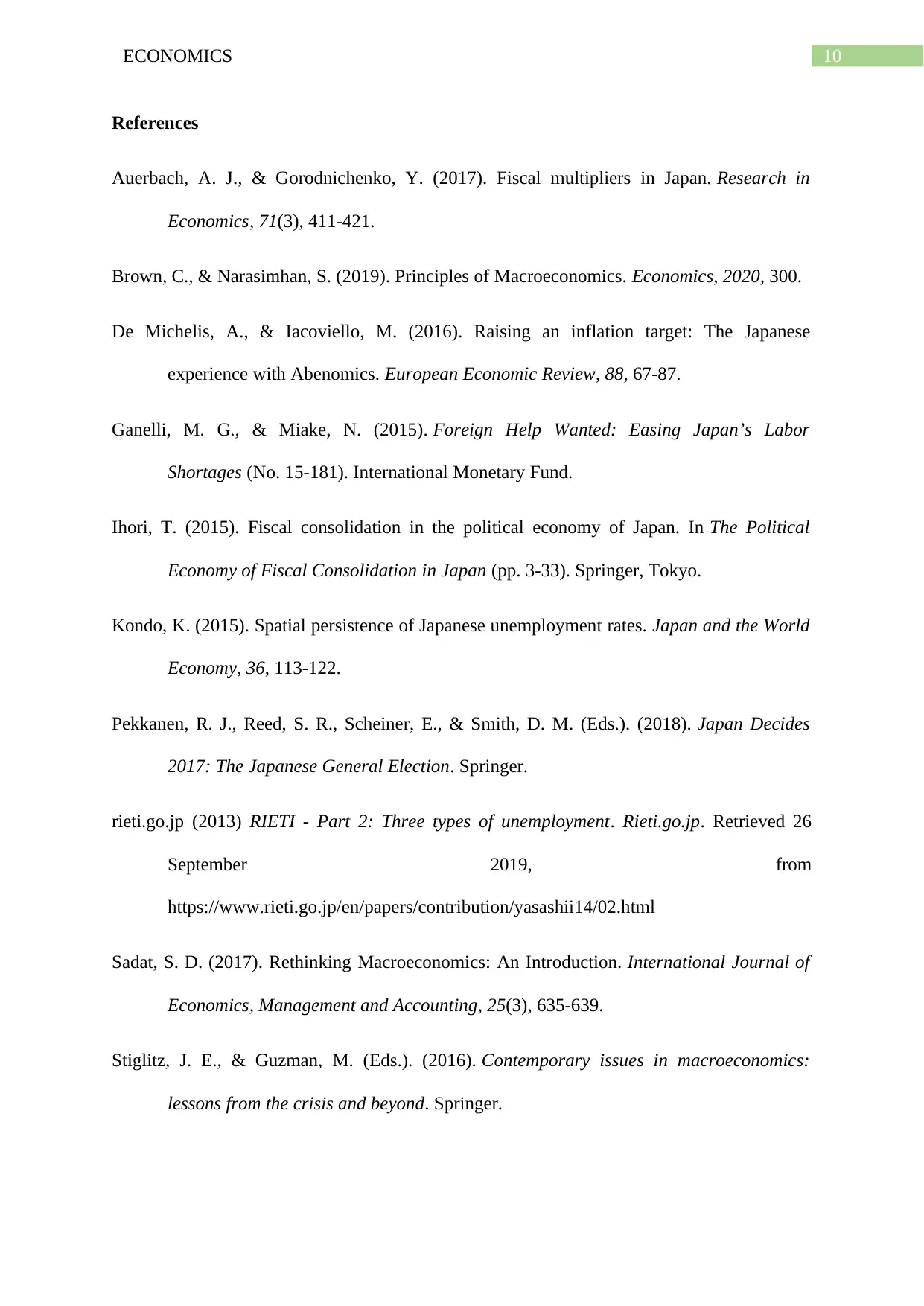
10ECONOMICS
References
Auerbach, A. J., & Gorodnichenko, Y. (2017). Fiscal multipliers in Japan. Research in
Economics, 71(3), 411-421.
Brown, C., & Narasimhan, S. (2019). Principles of Macroeconomics. Economics, 2020, 300.
De Michelis, A., & Iacoviello, M. (2016). Raising an inflation target: The Japanese
experience with Abenomics. European Economic Review, 88, 67-87.
Ganelli, M. G., & Miake, N. (2015). Foreign Help Wanted: Easing Japan’s Labor
Shortages (No. 15-181). International Monetary Fund.
Ihori, T. (2015). Fiscal consolidation in the political economy of Japan. In The Political
Economy of Fiscal Consolidation in Japan (pp. 3-33). Springer, Tokyo.
Kondo, K. (2015). Spatial persistence of Japanese unemployment rates. Japan and the World
Economy, 36, 113-122.
Pekkanen, R. J., Reed, S. R., Scheiner, E., & Smith, D. M. (Eds.). (2018). Japan Decides
2017: The Japanese General Election. Springer.
rieti.go.jp (2013) RIETI - Part 2: Three types of unemployment. Rieti.go.jp. Retrieved 26
September 2019, from
https://www.rieti.go.jp/en/papers/contribution/yasashii14/02.html
Sadat, S. D. (2017). Rethinking Macroeconomics: An Introduction. International Journal of
Economics, Management and Accounting, 25(3), 635-639.
Stiglitz, J. E., & Guzman, M. (Eds.). (2016). Contemporary issues in macroeconomics:
lessons from the crisis and beyond. Springer.
References
Auerbach, A. J., & Gorodnichenko, Y. (2017). Fiscal multipliers in Japan. Research in
Economics, 71(3), 411-421.
Brown, C., & Narasimhan, S. (2019). Principles of Macroeconomics. Economics, 2020, 300.
De Michelis, A., & Iacoviello, M. (2016). Raising an inflation target: The Japanese
experience with Abenomics. European Economic Review, 88, 67-87.
Ganelli, M. G., & Miake, N. (2015). Foreign Help Wanted: Easing Japan’s Labor
Shortages (No. 15-181). International Monetary Fund.
Ihori, T. (2015). Fiscal consolidation in the political economy of Japan. In The Political
Economy of Fiscal Consolidation in Japan (pp. 3-33). Springer, Tokyo.
Kondo, K. (2015). Spatial persistence of Japanese unemployment rates. Japan and the World
Economy, 36, 113-122.
Pekkanen, R. J., Reed, S. R., Scheiner, E., & Smith, D. M. (Eds.). (2018). Japan Decides
2017: The Japanese General Election. Springer.
rieti.go.jp (2013) RIETI - Part 2: Three types of unemployment. Rieti.go.jp. Retrieved 26
September 2019, from
https://www.rieti.go.jp/en/papers/contribution/yasashii14/02.html
Sadat, S. D. (2017). Rethinking Macroeconomics: An Introduction. International Journal of
Economics, Management and Accounting, 25(3), 635-639.
Stiglitz, J. E., & Guzman, M. (Eds.). (2016). Contemporary issues in macroeconomics:
lessons from the crisis and beyond. Springer.
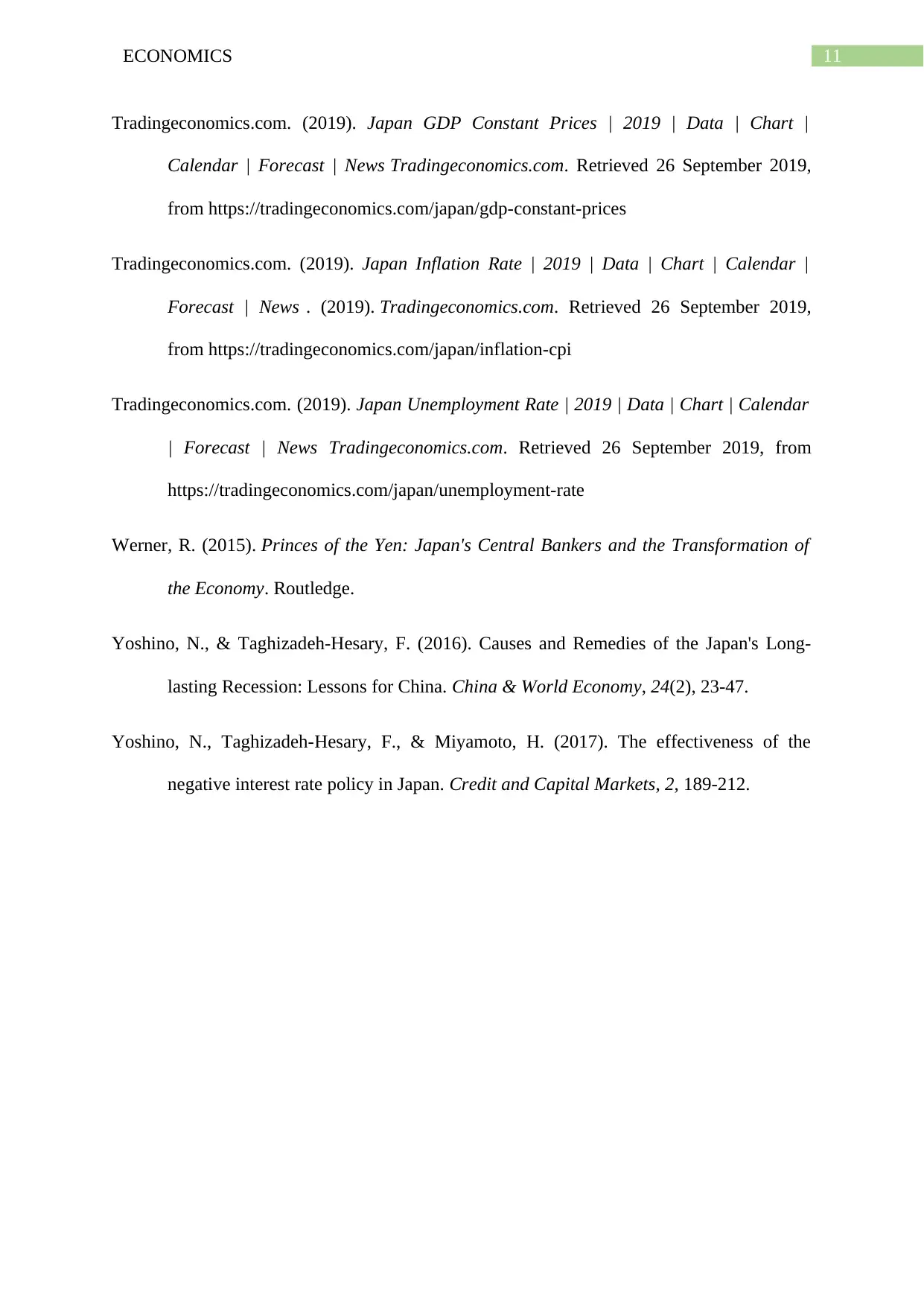
11ECONOMICS
Tradingeconomics.com. (2019). Japan GDP Constant Prices | 2019 | Data | Chart |
Calendar | Forecast | News Tradingeconomics.com. Retrieved 26 September 2019,
from https://tradingeconomics.com/japan/gdp-constant-prices
Tradingeconomics.com. (2019). Japan Inflation Rate | 2019 | Data | Chart | Calendar |
Forecast | News . (2019). Tradingeconomics.com. Retrieved 26 September 2019,
from https://tradingeconomics.com/japan/inflation-cpi
Tradingeconomics.com. (2019). Japan Unemployment Rate | 2019 | Data | Chart | Calendar
| Forecast | News Tradingeconomics.com. Retrieved 26 September 2019, from
https://tradingeconomics.com/japan/unemployment-rate
Werner, R. (2015). Princes of the Yen: Japan's Central Bankers and the Transformation of
the Economy. Routledge.
Yoshino, N., & Taghizadeh‐Hesary, F. (2016). Causes and Remedies of the Japan's Long‐
lasting Recession: Lessons for China. China & World Economy, 24(2), 23-47.
Yoshino, N., Taghizadeh-Hesary, F., & Miyamoto, H. (2017). The effectiveness of the
negative interest rate policy in Japan. Credit and Capital Markets, 2, 189-212.
Tradingeconomics.com. (2019). Japan GDP Constant Prices | 2019 | Data | Chart |
Calendar | Forecast | News Tradingeconomics.com. Retrieved 26 September 2019,
from https://tradingeconomics.com/japan/gdp-constant-prices
Tradingeconomics.com. (2019). Japan Inflation Rate | 2019 | Data | Chart | Calendar |
Forecast | News . (2019). Tradingeconomics.com. Retrieved 26 September 2019,
from https://tradingeconomics.com/japan/inflation-cpi
Tradingeconomics.com. (2019). Japan Unemployment Rate | 2019 | Data | Chart | Calendar
| Forecast | News Tradingeconomics.com. Retrieved 26 September 2019, from
https://tradingeconomics.com/japan/unemployment-rate
Werner, R. (2015). Princes of the Yen: Japan's Central Bankers and the Transformation of
the Economy. Routledge.
Yoshino, N., & Taghizadeh‐Hesary, F. (2016). Causes and Remedies of the Japan's Long‐
lasting Recession: Lessons for China. China & World Economy, 24(2), 23-47.
Yoshino, N., Taghizadeh-Hesary, F., & Miyamoto, H. (2017). The effectiveness of the
negative interest rate policy in Japan. Credit and Capital Markets, 2, 189-212.
⊘ This is a preview!⊘
Do you want full access?
Subscribe today to unlock all pages.

Trusted by 1+ million students worldwide
1 out of 12
Related Documents
Your All-in-One AI-Powered Toolkit for Academic Success.
+13062052269
info@desklib.com
Available 24*7 on WhatsApp / Email
![[object Object]](/_next/static/media/star-bottom.7253800d.svg)
Unlock your academic potential
Copyright © 2020–2026 A2Z Services. All Rights Reserved. Developed and managed by ZUCOL.





